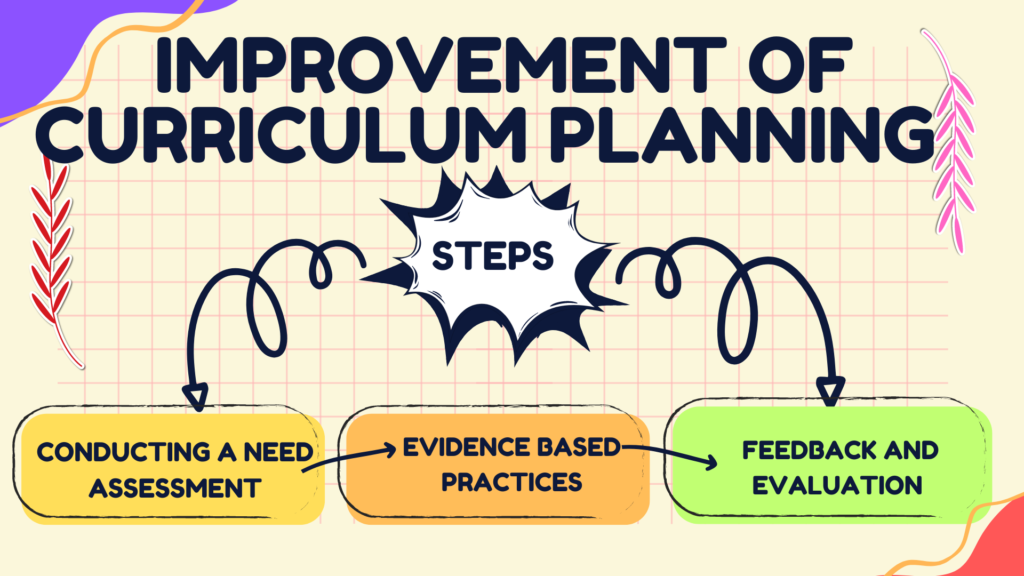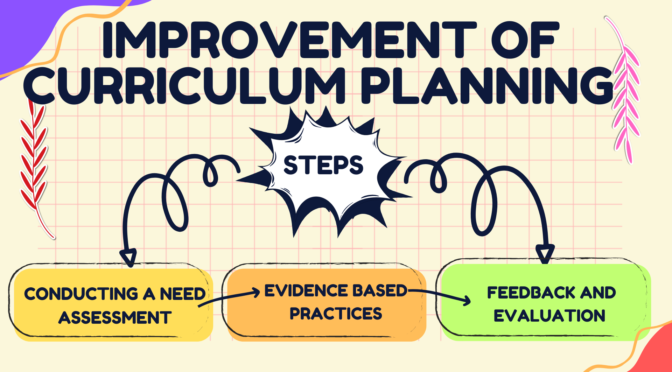Curriculum planning is a critical process in education that involves designing, developing, and implementing a course of study to achieve specific learning objectives. Effective curriculum planning ensures that students receive a quality education that meets their academic and professional needs. Improvement of Curriculum planning can be done by many ways.
Here are some ways to improve curriculum planning:
- Conduct a needs assessment:
Before planning a curriculum, it is essential to conduct a needs assessment to determine what students need to learn to succeed academically and professionally.
A needs assessment can involve surveys, interviews, focus groups, or other methods to gather information from students, educators, employers, and other stakeholders.
The information gathered from the needs assessment can help inform the curriculum design and ensure that it aligns with the needs of the target audience.
- Align curriculum with learning objectives:
Curriculum planning should begin with clearly defined learning objectives that specify what students should know and be able to do by the end of the course. Learning objectives should be specific, measurable, achievable, relevant, and time-bound (SMART). Once learning objectives have been established, the curriculum can be designed to achieve these objectives. Curriculum content and instructional methods should be aligned with the learning objectives to ensure that students are acquiring the knowledge and skills they need to succeed.
- Use evidence-based practices:
Effective curriculum planning involves using evidence-based practices to design and implement the curriculum. Evidence-based practices are instructional strategies and methods that have been demonstrated through research to be effective in achieving specific learning outcomes. Curriculum planners should stay up-to-date with the latest research and use evidence-based practices to design and implement the curriculum.
- Incorporate feedback and evaluation:
Curriculum planning should involve ongoing feedback and evaluation to ensure that the curriculum is effective and meeting the needs of students. Feedback can be gathered through surveys, focus groups, classroom observations, or other methods to assess student learning and identify areas for improvement. Curriculum planners should use the feedback to make necessary changes to the curriculum and improve the learning outcomes for students.
- Emphasize collaboration and communication:
Effective curriculum planning involves collaboration and communication among educators, administrators, students, and other stakeholders. Collaboration can help ensure that the curriculum is designed to meet the needs of the target audience and that all stakeholders are invested in its success. Effective communication can help ensure that all stakeholders are informed about the curriculum and that everyone understands their roles and responsibilities in its implementation.
Also Read : Impact of Science and Technology on Curriculum Development
In conclusion, improving curriculum planning involves conducting a needs assessment, aligning the curriculum with learning objectives, using evidence-based practices, incorporating feedback and evaluation, and emphasizing collaboration and communication. By following these steps, educators can create a quality curriculum that meets the needs of students and prepares them for success in their academic and professional pursuits.
Also Visit : Prep with Harshita



7 thoughts on “Improvement of Curriculum Planning”